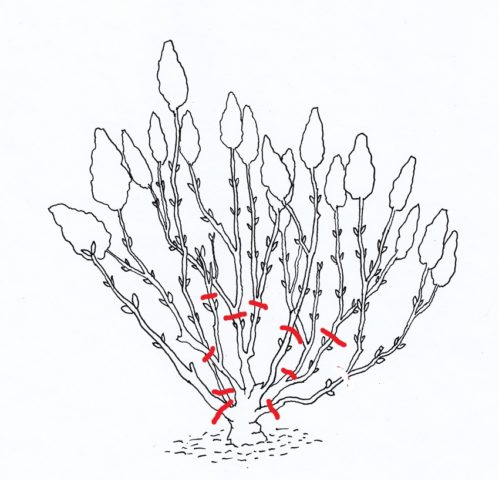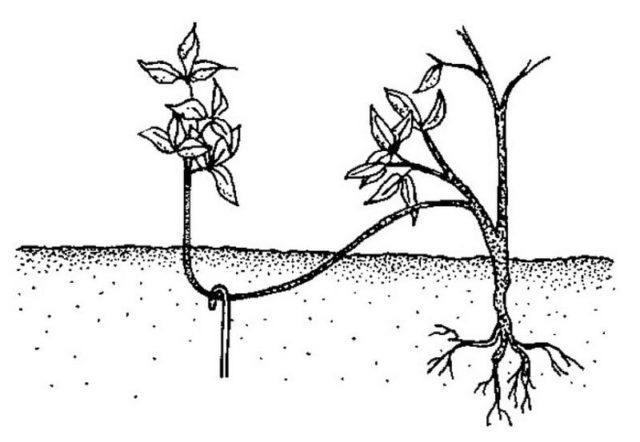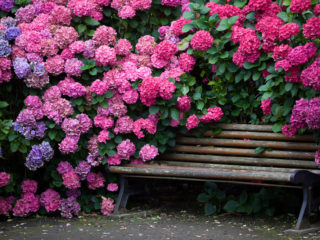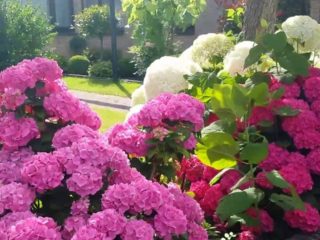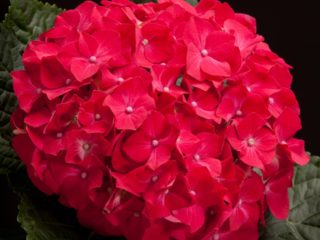Content
Hydrangea Mega Pearl is a fast growing shrub that is often used in landscaping. With proper planting and care, the culture grows on the site for about 50 years.
Description of hydrangea Mega Pearl
Hydrangea paniculata Mega Pearl (hydrangea paniculata mega pearl) is an abundantly flowering shrub. In nature, hydrangea is found on the southern coast of Sakhalin, on the islands of Japan and in China. Its height reaches 10 m.When grown in the temperate climate of Russia, the branches of the shrub stretch up to 2-2.3 m in length.
The Mega Pearl variety is adapted to heat and frost, therefore it is actively used in landscape design throughout Russia.
Hydrangea inflorescences are long panicles (up to 30 cm) with a creamy or greenish-white color.
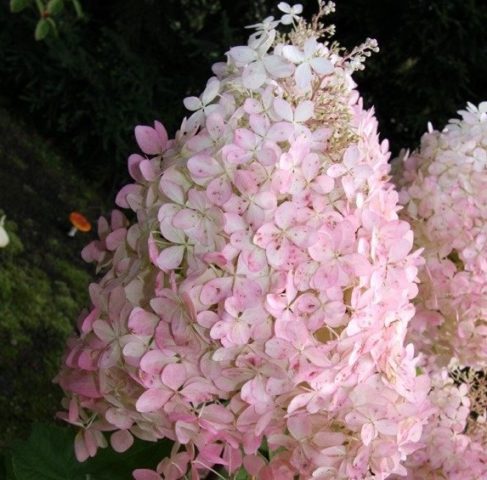
Fully opened flowers turn pinkish, and closer to fading - reddish
The flowering period is long, lasting from June to the end of September, and in warm regions until mid-October. After planting, the bush blooms no earlier than 4 years later.
The bark of an adult shrub is brownish-gray, with exfoliation. In young specimens it is pubescent, brown-green.
Leaves are dense, serrated at the edges. Their shape is elliptical, oblong, length - from 7 to 10 cm. The upper part of the leaf plate is dark green, and the bottom is slightly lighter, there is pubescence.
Hydrangea Mega Pearl in landscape design
Hydrangea Mega Pearl is often used to create hedges. Its height (about 2.5 m) and tough shoots make it possible to build a natural barrier in the garden.
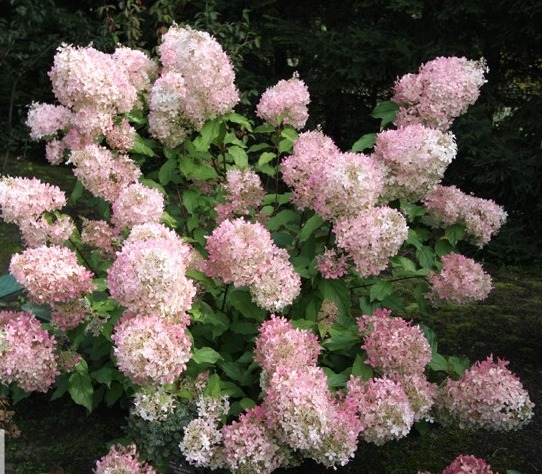
The spreading bush can be used as a tapeworm that will decorate the flower bed

Hydrangea is often used as a hedge, decorated with single or multi-colored varieties.
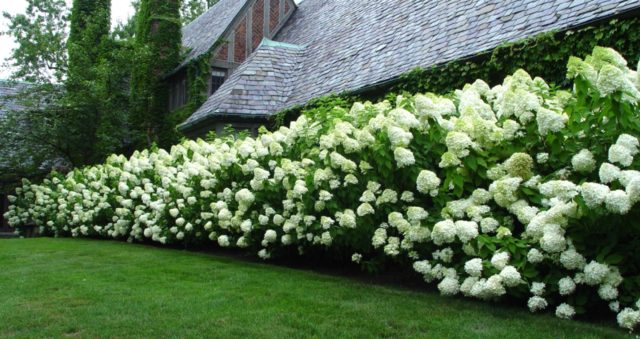
Saplings can be placed along the wall of the building
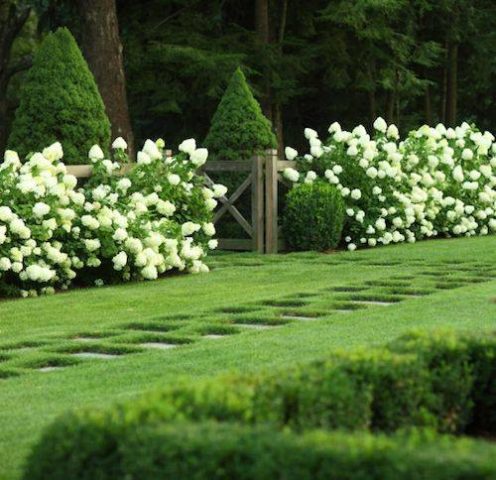
A landscape hedge of hydrangea looks unusually beautiful against the background of large-sized trees
Seedlings of hydrangea Mega Pearl are purchased by city gardening organizations, since this crop is often used to tamp the park area.
Winter hardiness of hydrangea paniculata Mega Pearl
Hydrangea panicle Mego Pearl belongs to deciduous shrubs with high winter hardiness. The variety has been tested throughout the European part of Russia, as well as in the Far East and Western Siberia. USDA hardiness zone 4, that is, the bush can withstand frosts down to -30 ° C. Young seedlings are less winter-hardy, so they need shelter.
Planting and caring for hydrangea Mega Pearl
For a plant to grow strong, spreading and lush, it needs proper care. The planting site is no less important, because each culture has its own requirements for the composition of the soil, its acidity, as well as for illumination and watering.
Selection and preparation of the landing site
The Mega Pearl variety takes root well on abundantly moist, highly drained soils. Stagnation of moisture is unacceptable, therefore, when planting, they provide for laying a drainage layer.
The primer is preferable with a slightly acidic or acidic reaction. If the indicator is alkaline, then you can acidify the soil by introducing humus, manure, coniferous litter. Clay soil must be mixed with sand, peat, earth from a coniferous forest.
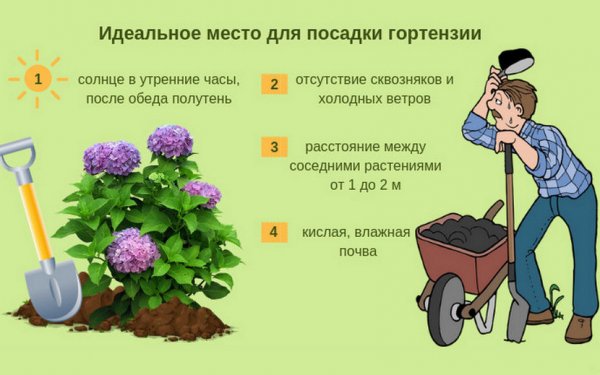
It is better to land Mega Pearl on a lighted area, which is in partial shade at noon
Too hot daytime rays can burn the foliage, which will affect the period and quality of flowering.
Landing rules
To plant a crop correctly, you must adhere to the following recommendations:
- the size of the hole depends on the root system of the seedling. Approximate dimensions of the landing pit: 35-50 cm - depth, 40-50 cm - diameter;
- for planting, a nutritious soil mixture is needed. You can cook it yourself. To do this, mix the sod layer of the earth with sand, peat, organic fertilizers;
- when planting several seedlings, a distance of at least 1 m is left between them. A hedge can be planted in one or two lines. If a dense fence is needed, holes are dug in a checkerboard pattern;
- the root system of the seedling is inspected for rotten and damaged areas. If detected, they are removed, too long roots are shortened;
- when buying seedlings with an open root system, they are soaked in water with the addition of a growth stimulator before planting. Seedlings in shipping pots are planted by the transshipment method, without preliminary soaking;
- the prepared soil mixture is poured into the hole. A hydrangea is placed on it, gently spreading the roots. Then they fall asleep with the remaining soil, slightly tamping each layer;
- the root neck of the Mega Pearl hydrangea is not added dropwise, leaving it flush with the surface;
- the seedlings are watered, and the trunk circle is covered with mulching materials. It can be peat, humus, wood chips, sawdust.
Watering and feeding
Mega Pearl is a moisture-loving hydrangea that is watered at least twice a week. Each hole will require about 20 liters of water. The procedure is carried out during dry periods. If it rains, the watering rate is reduced. Mulch helps to retain moisture and reduce watering.

For hydrangeas, chlorine-free water is used, you can collect rainwater or defend tap water
Water for irrigation should be at room temperature. Moisturizing hydrangeas Mega Pearl is carried out carefully, pouring the liquid strictly under the root. In order not to harm the decorative effect of the culture, it is necessary to avoid getting drops of liquid on foliage and flowers.
The plant is fed 2 years after planting. Nutrients are applied three times per season:
- mineral compositions are necessary during the appearance of the first shoots;
- when forming buds, they are fed with potassium sulfide and superphosphate, which are taken in a ratio of 3: 1. 10 liters of water will require 100 g of dry mixture;
- in the last decade of August, panicle hydrangea is fed with mullein infusion. To do this, the manure is diluted in water in a ratio of 1: 3, insisted for at least 7 days. The resulting concentrate must be diluted with water in a ratio of 1:10 before watering.
Pruning hydrangea Mega Pearl
Mega Pearl is an ornamental hydrangea that requires pruning. The procedure allows:
- achieve lush flowering;
- create an attractive shape;
- rejuvenate the culture by extending its lifespan.
Spring pruning is carried out before bud break.
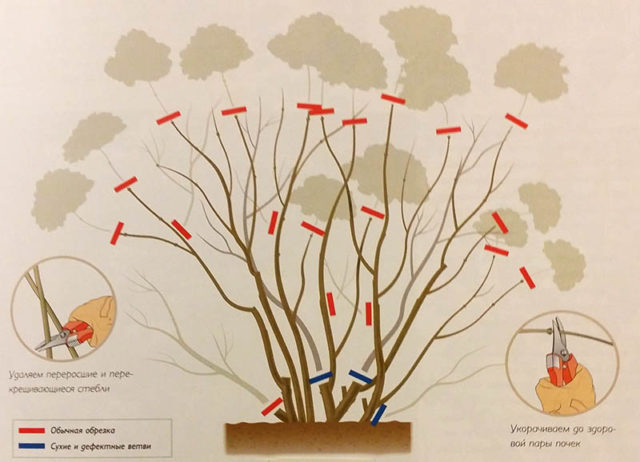
Cut off thickening, inward-directed crowns, frost-damaged or wind-damaged shoots
The rejuvenating procedure is carried out in different ways:
- on bushes that are more than 5-6 years old, no more than 10 skeletal shoots are left, the rest are cut off;
Rejuvenation is carried out in several years
- all shoots are cut on a stump, that is, the culture can be rejuvenated in 1 year.
Faded flowers must be cut off for the winter.
Preparing for winter
Young seedlings of hydrangea Mega Pearl must be covered for the winter. Adult specimens that overwintered in a shelter bloom earlier and much more luxuriantly than bushes that are not warmed in autumn.
The roots of the hydrangea are covered with a thick layer of mulch. They use peat, sawdust and other natural materials. The layer must be at least 30 cm.
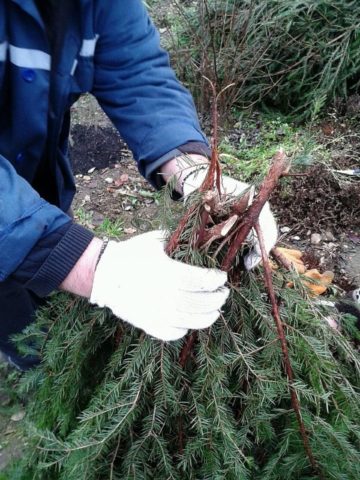
To insulate the shoots, stakes are driven in around the bush, on which spruce branches are attached
The construction is tightened with spunbond.
Reproduction
Most often, the Mega Pearl hydrangea is bred using cuttings or layering. The seed method is lengthy and ineffective, therefore it is not suitable for home breeding.
Cuttings are cut in the spring. Each must have at least two buds. Cut shoots are placed in peat at an angle of 60 °. The lower kidney should be under the ground. The seedlings are watered, covered with foil and kept in greenhouse conditions until rooting. The transplant is carried out next spring.
Cuttings of the Mega Pearl hydrangea can also be carried out in the summer. To do this, cut the shoots, remove the lower leaves from them and shorten the upper ones. Placed in a solution that stimulates root formation. Then they are planted in a container with peat or nutritious soil mixture. Close with a jar. Water it periodically, preventing the soil from drying out. After about a month, the cutting will take root. From this point on, the can is periodically removed so that the seedling gets used to the environment. They are planted in the ground for the next season.
The layering method is as follows:
- the lower branch of the hydrangea is bent in the spring and buried in the ground;
The escape is secured with a wooden or metal staple
- periodically watered and loosened;
- when new shoots appear, they are spud up every 7 days;
- separated from the mother bush after a year.
Diseases and pests
Diseases of the hydrangea Mega Pearl are associated with metabolic disorders, as well as viral and fungal infections.
Chlorosis causes yellow foliage and deformation of buds. The cause of the pathology is a lack of nutrients (iron). To eliminate the disease, use Ferovit, Antichlorosis or a self-prepared solution. This will require the following components:
- iron vitriol - 1 g;
- citric acid - 2 g;
- water - 0.5 l.
Fungal and viral diseases of hydrangea Mega Pearl: peronosporosis, powdery mildew, septoria, viral ring spot. To combat these pathologies, Skor, Topaz, Fitosporin, Fundazol, a solution of copper sulfate are used.
Of the insects on the Mega Pearl hydrangea, gall nematodes, aphids and spider mites parasitize. To combat them, Commander, Akarin and other insecticides are used.
Conclusion
Hydrangea Mega Pearl is a flowering shrub used in ornamental gardening. With proper care, it is virtually hassle-free. It reproduces easily at home. The culture is characterized by high winter hardiness, therefore, it needs shelter only when grown in the northern regions.
